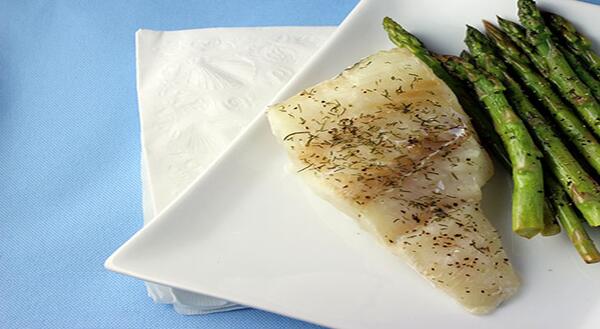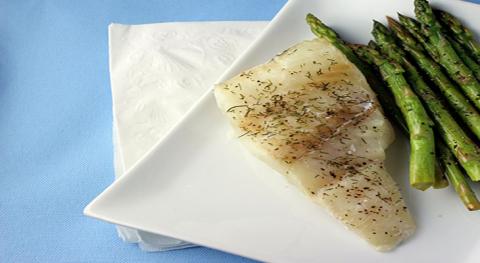
Dill is an interesting plant. In the kitchen, cooks have a choice of fresh and dried dill weed (the leaves) or dill seed for their recipes. Each provide their own flavors and preferred applications. Dill weed is generally more mild than the seeds, adds color to dishes, and provides better flavor when added towards the end of cooking. Dill seeds can stand up to long cooking times and tend to have a stronger flavor. From pickles to soups and salads to dips, dill is one versatile plant.
Nutrition
Like many herbs and spices, cooks do not use a large enough quantity of dill to add many nutrients. While only very small amounts of vitamins and minerals might be added to your recipes, herbs and spices do add a lot of flavor without adding sodium.
- Grow: For more about growing your own dill, read resources from your local Extension office.
- Buy: Choose the form of dill recommended in your recipe. If buying fresh, look for dill that is bright green and does not show signs of mold, wilted leaves, or other decay. If buying dried, check the “use by” date on the package and choose one with a date as far off as possible.
- Price: Price will vary by type of dill and brand. Choose what fits in your budget. As a general recommendation, use a third less of a dried herb as compared to fresh, since dried is more potent.
- Store: Avoid washing fresh dill before storing. Store in the refrigerator for to 2 weeks, limiting exposure to water or condensation. For dried dill weed and seed, store in a cool, dark area at room temperature.
- Prepare: Wash fresh dill before using in recipes. Cut or tear into desired size pieces for your recipe. For dried dill weed or seed, simply measure and use in the recipe.
- Eat: Dips, soups and salads, and meats are popular recipes that use dill. And pickles!
Dilled Fish Fillets (serves 4)
1 lb. frozen haddock or cod fillets, thawed
1 tablespoon lemon juice
1/8 teaspoon dried dill weed
1/8 teaspoon salt
dash of black pepper
- Put frozen fish in refrigerator overnight or thaw in microwave oven and separate into four pieces.
- STOVETOP METHOD: Spray frying pan with non-stick cooking spray. Place thawed fish in heated frying pan. Sprinkle fish with lemon juice and seasonings. Cook covered over medium heat until fish flakes when tested with a fork, about 5 minutes.
- MICROWAVE METHOD: Spray a glass baking dish with non-stick cooking spray. Place fish in dish and cover dish with wax paper. Cook at medium power for 3 minutes. Remove wax paper, turn fish over, and sprinkle with lemon juice and seasonings. Cover and continue cooking at medium power for 3 minutes or until fish flakes with a fork.
Nutritional Information per serving: 80 calories, 0g fat, 420mg sodium, 0g carbohydrates, 0g dietary fiber, 17g protein
Source: Eat.Move.Save. Illinois Nutrition Education Programs. University of Illinois Extension.
References:
- North Dakota State University Extension Service. Field to Fork. Dill. 2019
- SPICEography. Dill Seed Vs. Dill Weed: SPICEography Showdown. N/D.
- Texas A&M AgriLife Extension. Dill. N/D.
- University of California. UC Master Gardener Program of Sonoma County. Harvesting and Preserving Dill. N/D.
- University of Illinois Extension. Herb Gardening. Dill. N/D.
- University of Minnesota Extension. Growing dill in home gardens. 2018.
- USDA. Agricultural Research Service. National Nutrient Database for Standard Reference Release 27
Healthy Eats and Repeat
How much difference is there between canned and frozen foods? How should you cook venison? When is the best time to buy avocados? Get answers to these questions as well as other tips, tutorials and recipes for common kitchen foods and items with University of Illinois Extension Nutrition & Wellness Educator Caitlin Mellendorf’s blog Healthy Eats and Repeat. Build your best life. Trust Extension to help.
Caitlin Mellendorf is an Illinois Extension Nutrition and Wellness Educator serving DeWitt, Macon and Piatt Counties in Central Illinois. She is a Registered Dietitian and her work focuses on helping community members gain the knowledge, skills and tools to live healthier, more nutritious lifestyles. This includes providing programs and answering questions about heart health, diabetes, food safety, food preservation, grocery shopping and cooking. You can reach Caitlin by email at chuth2@illinois.edu or call 217.877.6042. Check out her nutrition blog Healthy Eats and Repeats for seasonal recipes and of an exploration of common kitchen foods.
